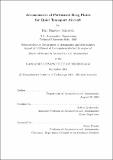| dc.contributor.advisor | Zoltan Spakovszky. | en_US |
| dc.contributor.author | Sakaliyski, Kiril Dimitrov | en_US |
| dc.contributor.other | Massachusetts Institute of Technology. Dept. of Aeronautics and Astronautics. | en_US |
| dc.date.accessioned | 2006-06-20T12:56:51Z | |
| dc.date.available | 2006-06-20T12:56:51Z | |
| dc.date.copyright | 2005 | en_US |
| dc.date.issued | 2005 | en_US |
| dc.identifier.uri | http://hdl.handle.net/1721.1/33212 | |
| dc.description | Thesis (S.M.)--Massachusetts Institute of Technology, Dept. of Aeronautics and Astronautics, 2005. | en_US |
| dc.description | This electronic version was submitted by the student author. The certified thesis is available in the Institute Archives and Special Collections. | en_US |
| dc.description | Includes bibliographical references (p. 195-197). | en_US |
| dc.description.abstract | Historically aircraft noise is one of the principal environmental issues for aviation. Within this context, the Silent Aircraft Initiative was launched with the objective to achieve a step-change in noise reduction compared to current practice. One of the most critical tasks in noise reduction is to develop technologies to increase drag in quiet ways. The work presented in this thesis focuses primarily on aeroacoustic tests and analysis of perforated drag plates. The idea behind a quiet spoiler or drag rudder is to alter the noise production mechanism by perforating the drag plates. The hypothesis is that the large length scales responsible for the noise radiated by unsteady vortical structures can be changed to small length scales driving jet noise at frequencies which are perceived unannoying by the human ear. The aeroacoustic characteristics of laboratory-scale perforated spoilers were measured in an acoustic chamber at MIT. Based on the experimental data a noise prediction model was developed for the bluff-body and turbulent mixing noise generated by a perforated drag rudder. Acoustic phased array measurements of seven perforated plates in four different installation configurations were conducted in the Markham wind tunnel at Cambridge University to further investigate the noise mechanisms. | en_US |
| dc.description.abstract | (cont.) The analysis of the test results showed that there are two identifiable peak frequencies which scale with free stream velocity. Different candidate length scales were investigated with the goal to collapse the data on a Strouhal number basis. However, a universal length scale was not found. It was hypothesized that the noise is mainly due to the isotropic turbulence generated behind such perforated plate. Due to the high background noise levels in the experiments the impact of the perforations on the low frequency noise signature could not be assessed. A perforated plate of 28:19% porosity with a hole diameter to plate length ratio d/L of 0:013 and a non- dimensional hole separation s/L of 0:0217 was identified to be the most beneficial plate in terms of noise reduction. The experiments showed that a spoiler mounted on the suction surface of the wing is the quietest configuration. In order to scale the results to full size, the observed peak magnitudes are suggested to scale with the 4th power of the free stream velocity. In addition, the overall sound pressure levels were found to scale with plate size such that an increase in source area causes an equivalent increase in the acoustic power. | en_US |
| dc.description.abstract | (cont.) The developed models were used to predict the noise signature of a full sized drag rudder which enabled a 6⁰ glide slope angle resulting in a 4 dBA reduction in cumulative sound pressure level of the candidate SAX10 Silent Aircraft design. | en_US |
| dc.description.statementofresponsibility | by Kiril Dimitrov Sakaliyski. | en_US |
| dc.format.extent | 197 p. | en_US |
| dc.format.extent | 8786278 bytes | |
| dc.format.extent | 8797909 bytes | |
| dc.format.mimetype | application/pdf | |
| dc.format.mimetype | application/pdf | |
| dc.language.iso | eng | en_US |
| dc.publisher | Massachusetts Institute of Technology | en_US |
| dc.rights | M.I.T. theses are protected by copyright. They may be viewed from this source for any purpose, but reproduction or distribution in any format is prohibited without written permission. See provided URL for inquiries about permission. | en_US |
| dc.rights.uri | http://dspace.mit.edu/handle/1721.1/7582 | |
| dc.subject | Aeronautics and Astronautics. | en_US |
| dc.title | Aeroacoustics of perforated drag plates for quiet transport aircraft | en_US |
| dc.type | Thesis | en_US |
| dc.description.degree | S.M. | en_US |
| dc.contributor.department | Massachusetts Institute of Technology. Department of Aeronautics and Astronautics | |
| dc.identifier.oclc | 67771647 | en_US |
